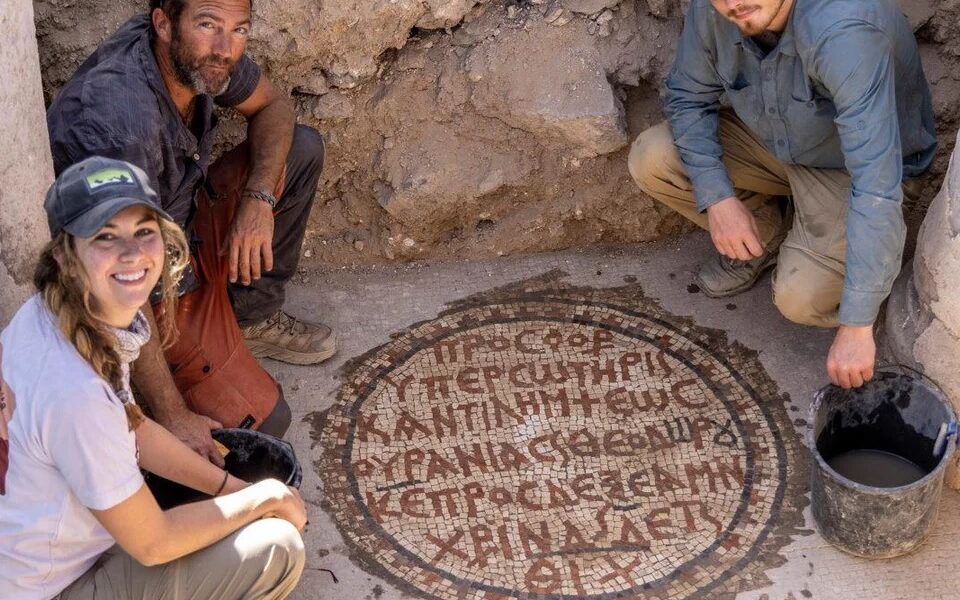New discoveries at a Greco-Roman city perched high above the Sea of Galilee, the Hippos (Sussita) of the Decapolis, suggests that ancient people were deeply religious.
No less than seven churches have been found in the city from the early Christian era, Haaretz reported.
Now, four inscriptions newly discovered in one of its ancient churches – the Martyrion of Theodoros, or “Burnt Church” – during the summer 2022 excavation season shed rare personal light on actual people.
So say excavation directors Dr. Arleta Kowalewska and Dr. Michael Eisenberg of the Zinman Institute of Archaeology at the University of Haifa, and epigraphist Prof. Gregor Staab of the Institute of Classical Studies at University of Cologne.
Two of the four inscriptions, revealed here for the first time, were exposed by the expedition conservator Yana Qedem while conserving previously found mosaics in the Martyrion. They were quite the surprise.
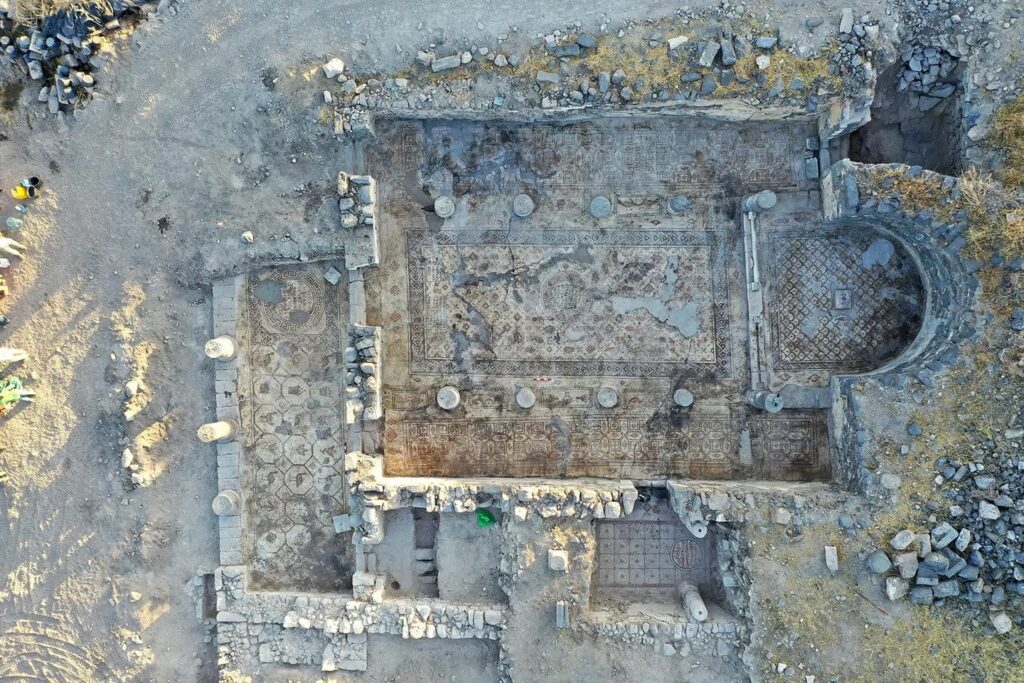
As the archaeologists were delicately removing dirt of the ages and soot from the conflagration, the colors and images started to show.
“Suddenly, two concentric black lines appeared in front of the main portal of the church. We realised there must be an inscription here,” says Jessica Rentz, a doctoral candidate at the Catholic University of America and field supervisor of the church area.
Altogether, seven inscriptions have been found in the Martyrion of Theodoros to date, which is a lot, Kowalewska says.
For the first time, we learn names of people in the city. From a mosaic prominently positioned in the entrance hall of the church, for instance, we learn of Megas the “most holy bishop,” who sponsored the main mosaic of his brothers Eusebiοs and Iobiοs, for whose souls Megas advocated in a mosaic at the very entrance to the church.
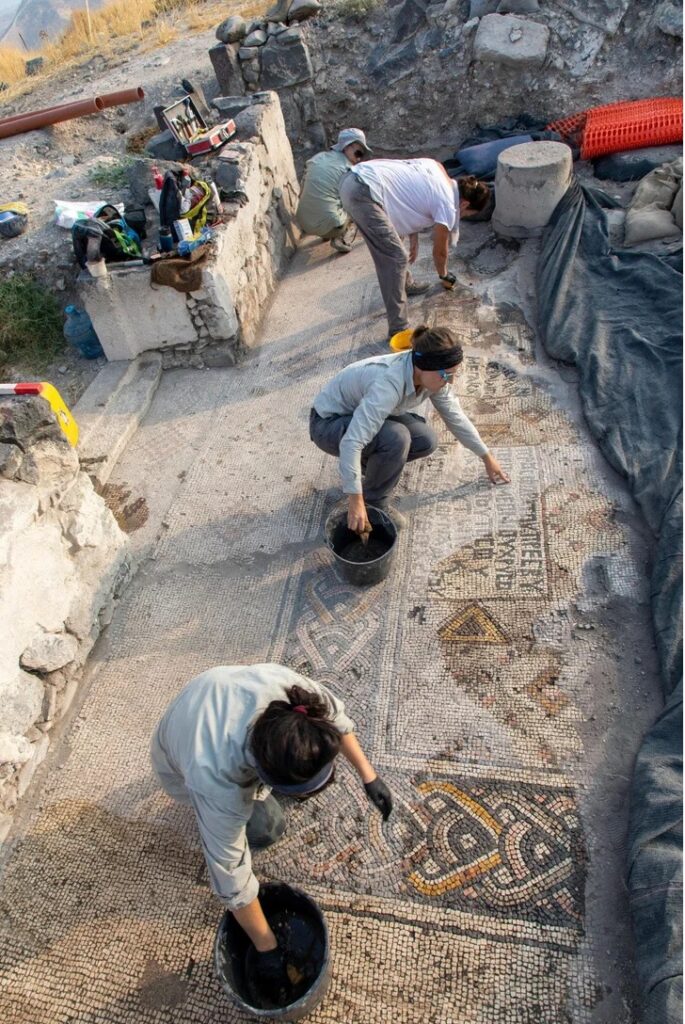
An inscription in the side chapel reads: “Offering in favor of salvation and succor for Urania and Theodoros. Lord God, accept! Amen! In the time of indiction 4 and year 619,” according to Staab’s interpretation of the Greek text.
It seems these two private individuals installed a kind of private chapel as a final resting place for themselves in an adjoining room, he suggests.
Another mosaic implies that a minister could be a metalworker too, as Staab translates it: “Offering of the priest Symeonios, goldsmith, custodian [?], He [the Lord] will protect him and his children and his wife” (Zeitschrift für Papyrologie und Epigraphik 222, 131–137).
Taken together, the writings bolster a previously held suspicion that Greek wasn’t widely spoken in the city anymore. Spelling and grammatical mistakes suggest Greek had become bastardized in the Holy Land, mixed up with local tongues.
If no longer spoken, why would the inscriptions be in Greek? “In the ecclesiastical world, it was unthinkable to come up with the idea of using a language other than Greek – even if one was aware that this language was no longer mastered to the extent actually required,” Staab explains. “The original language of Christian liturgy and prayer to God was Greek, so it had to be considered impossible to deviate from using it in the Christian context (and so in the mosaics too).”
In another new development, a numismatic report that arrived last week supports the theory that the Burnt Church had burned down before the Islamic era, Eisenberg reveals: All coins and other artifacts found in its context predate the Islamic period, lending support to the theory that the church was destroyed by fire during the Persian Sassanid invasion of 614.

The Martyrion of Theodoros was built in the second half of the fifth or early sixth century at the westernmost part of the city, overlooking Lake Kinneret. In 2019, the team reported inscriptions attributing the construction of the Martyrion to the abbot Petros, and naming the martyr Theodoros.
As befits Byzantine style, the Burnt Church was adorned with mosaic carpets and inscriptions. But the art and language in its mosaics were of mediocre quality.
Of the seven churches found in Hippos to date, the Burnt Church was the farthest from the colonnaded city center, and it was built in what seems to have been the poorest neighborhood, Eisenberg says.
From the atrium, the faithful had a spectacular view – better than the other churches offered – of the Sea of Galilee, including all the sites where Jesus is said to have performed his miracles. Yet the environs and the mosaics’ crude quality suggest that the local community behind the construction could not afford a top-notch artisan. The images are colorful but naïve. The church is relatively small. Thus, the team believes it is uncovering a neighborhood church for simple folk.
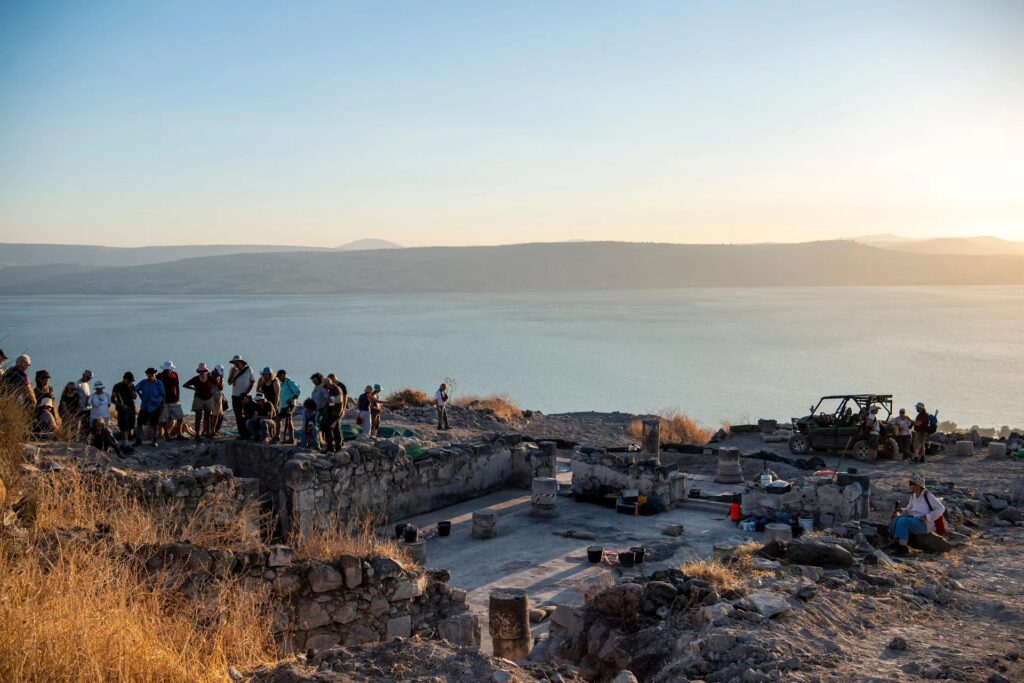
Yet while the mosaics are somewhat crude, the images brim with Christian symbolism. On the church floor, a crowded mosaic shows 12 baskets – each holding five pieces of bread or five fruits (it’s hard to say). These would represent the 12 baskets left following Jesus’ miracle of Feeding the Multitude next to the Sea of Galilee. (Eisenberg shares their apprehension that more than 12 baskets would be found as excavations continued. So far, so good.) Mosaics in the church, down the nave and in the apse, features fish.
Inquiring minds wonder, which fish? None is identifiable as local species. Ditto the peacock and some other birds that do not and did not exist in the Holy Land.

Eisenberg’s theory? The humble residents of this simplest neighborhood in Hippos pooled resources and hired a low-cost craftsman to translate their beliefs into stone – and so it came to pass, but using images in the artisan’s repertoire, not original work based on local models.
Twelve baskets are 12 baskets, no room for license there. And the people could ask for two fish facing one another, as was done in the apse mosaic, and likely didn’t care which species.
As for the peacock: there aren’t any in the Galilee, but it is common in Byzantine mosaics and bears Christian symbolism.
Hence, we could be seeing Nilotic fish and a bird originating in the Indian subcontinent in a fifth/sixth-century church atop a plateau in the Galilee. Or the fish could be figurative.
Another image heavy with symbolism is a rare one: a fruiting date palm, Eisenberg says.
During the Christian era, Hippos of the Decapolis ruled the region, the southern Golan and most of the lake’s eastern shore. It arose in the Hellenistic period, but aside from a name stamp on an amphora, the oldest inscriptions in the city are three from the second or third centuries C.E. naming Roman functionaries on monuments, and the remains of a base that probably originated in the Roman basilica, on which a statue of Emperor Septimius Severus (193-211) had been worshipped, Staab says.
Small inscriptions have also been found in private homes and on precious items such as a ring, a seal and even on the head of an ornamental nail.
An inscription found in the city periphery may attest to worship of a Nabataean nature deity called Dusares (god of ash-Shara near Petra), he says – then we come to the Byzantine period.
The inscriptions from the Christian era include eight – in stone and in mosaics – in the main church, called the cathedral, Staab says, one dating its rebuilding to 591. This is about 35 years later than the Burnt Church. Other mosaics found in the so-called north-west church attest to the female ministry of a deaconess Antonia in the sixth and seventh century.
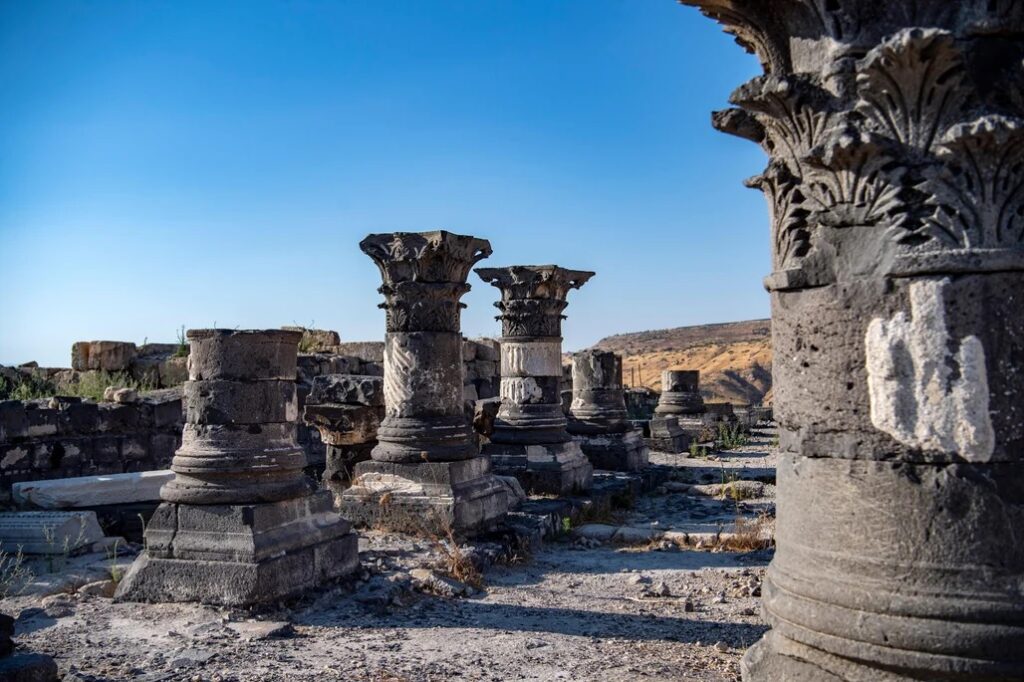
Now with the four revealed this year in the atrium and side room, the count in the Burnt Church rises to seven. Others could emerge as more of the atrium and the church wings are explored, Kowalewska says.
The bishop’s inscription was damaged, but Staab could reconstruct most of it: “Offering of Megas, the most holy bishop, for the peaceful rest of Eusebiοs and Iobiοs, his brothers, in the year 620, indiction 4.”
The “Urania and Theodoros” inscription cited the year 619 and indiction 4 as well. The difference in dating between the two mosaics raises the question of when the year in Hippos actually began (or that somebody got their date wrong).

Like other Decapolis cities, Hippos counted dates from the Roman general Pompey’s recorded triumph over the Hasmoneans in 64 B.C.E. The entire region under Hippos’ control would have used this Pompeian count of years for the region’s internal purposes.
The years 619 and 620 in the mosaics don’t refer to 619 and 620 C.E., but to the count of years in the “Hippos era” or “Pompeian era.” In familiar terms, the 620 C.E. mosaic was laid down in 556 or 557 C.E.
“Indiction 4” refers to the fourth year of the 15-year Byzantine administrative cycle and must cover the period from September 555 to August 556, Staab and Eisenberg explain.
To sum up, the dates indicate that the two mosaics were laid down inside less than a few months: the team is hopeful that further analysis may shed light on the question of whether the “year” in Hippos started earlier than elsewhere in the region.
In any case, command of Greek seems to have deteriorated by this time.
“The language of the mosaic inscriptions shows a remarkably strong decline both in the phonetic rendering and in the grammatical rules,” Staab says. However, he qualifies: “It is difficult to draw clear conclusions from this, such as whether the people of Hippos – up to and including the clergy – no longer practiced Greek in its pure form and whether their language in everyday life was more or less blended with local influences such as Aramaic.”
Whatever language was spoken, the latest discoveries bring to life another aspect of worship at the Burnt Church: possible segregation.
“We know where the people stood. We know the doorways were left open during the ceremony,” Eisenberg says. “We find the ashes of the main portals, on which were the beautiful lion-head door-pulls [found in a previous excavation] – and the chain keeping out the people who were not yet full Christians, not yet baptized. They stood in the portico of the court, where one of the new mosaics was found. They would stand outside the ecclesia looking into the Eucharist.”
It sounds achingly relatable, and so does Staab’s explanation of why the Byzantine churches had these inscriptions.
“All mosaics mention persons by name who contributed to the construction and mosaic furnishing of the church; and all donations still reveal the pagan ‘do-ut-des’-mentality – which means that a contribution to the ‘sanctuary’ was seen as a donation to God, who is ‘paid in advance’ for the fulfillment of an individual request,” he explains.
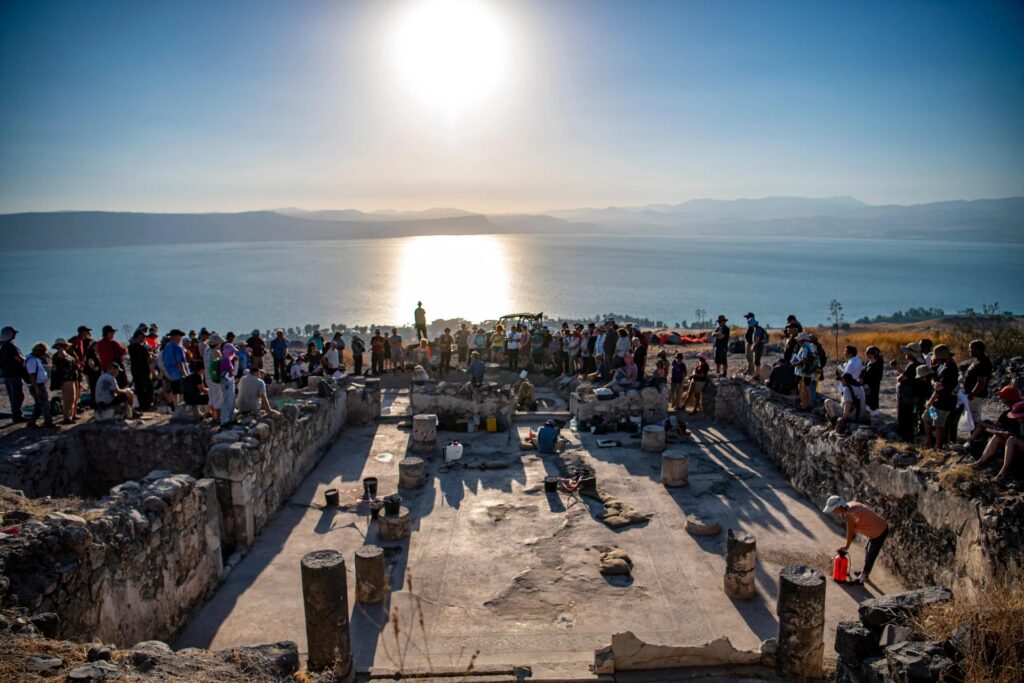
With the excavation between seasons, all the mosaics have now been re-covered with earth for the sake of their preservation.
The Hippos project is seeking private donations to pursue further excavation of the Martyrion of Theodoros, preserve it and open the site to the public. And if your idea of heaven is physical labor at an excavation on a hilltop overlooking the Sea of Galilee during the burning Israeli summer, you are welcome to join the effort to dig up ancient Hippos, in the Sussita National Park managed by the Israel Nature and Parks Authority, Eisenberg says. (Don’t just show up; register at https://www.dighippos.com.)
The medallion discovered in the southern wing this summer could lead to a baptistery where the postulated forlorn worshippers outside the church could achieve acceptance. “To be sure, it leads somewhere, and maybe next year’s excavation will find out where,” Eisenberg sums up.
READ MORE: Rare Mosaics of Europa and Orpheus Showcased in House of Mosaics, Sparta.

